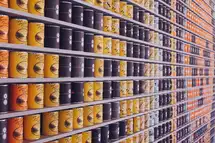What are types of inventory management?
There are several types of inventory management, each with its own advantages and disadvantages. The most common types are- -Just in time (JIT) inventory management -Economic order quantity (EOQ) -Inventory turnover -Days inventory outstanding (DIO)
The Pros and Cons of Different Types of Inventory Management Systems
What is Inventory Management?

For businesses, it's important to be efficient with money in order to see consistent growth. Success or failure can come down to a business's ability to save costs without compromising the quality of its product or service. Reducing fixed and variable costs is a key way to meet this goal; this is where inventory management comes in. By tracking inventory, from when it's purchased to when it's sold, businesses can ensure they always have enough stock to meet customer demand. By identifying and reacting to trends, businesses can avoid stock shortages. A business can also save significant money in the long run by growing strategic about what it orders, and by keeping track of what it has.
An inventory management system can help your business in a variety of ways. For example, it can track your stock's movement, help keep tabs on inventory levels, and even assist with forecasting future inventory needs by monitoring the total sale, supply chain movement, and safety stock in real time.
How Can Good Inventory Management Benefit a Business?
- Inventory Management is key for businesses to stay afloat and operate efficiently by keeping track of a company's inventory, where it is, and how to utilize it best. In today's fast-paced business world, being able to adapt and quickly change directions is essential for success, and inventory management gives companies the agility they need to pivot when necessary.
- Real-time inventory tracking helps improve Demand Planning and ensures that businesses have the optimal stock available to fulfill orders. With accurate inventory tracking, businesses can eliminate over-stocking and reduce costs and manual efforts related to maintaining inventory.
- When inventory is managed properly, it cuts down on the need for excess funds set aside to cover errors, leaving more money available to reinvest back into the company. This can take the form of employee payroll, product development, or any number of other business functions. Fewer errors would require fewer resources to be spent on damage control, allowing those resources to be allocated elsewhere.
- Automating your inventory management process can save you time in a number of ways. By leveraging machine-learning and artificial intelligence (AI), you can free up employees to work on more important tasks and help devise strategies for business growth. In addition, automating these tasks can also help improve your forecasting accuracy and optimize other business processes.
- Automating your inventory management can help you speed up tasks like barcode scanning and data transfer between different departments. Additionally, it allows you to keep a closer eye on your business as a whole and identify potential issues early on.
Too much or too little inventory can both be bad for business.
A good inventory management system can keep your stocks and your finances in balance.
No. 1- Perpetual Inventory

A perpetual inventory system is an automated record-keeping system that continuously keeps track of inventory in real time. A computer program follows set rules and keeps the system up to date. Perpetual inventory systems update inventory counts as employees' record sales, purchases, and returns via Point of Sale systems. The system's name comes from the computerized process of updating the inventory. The main advantage of cloud-based inventory management systems is that they work in real time, a key element of perpetual inventory systems.
Perpetual inventory allows for more real-time inventory tracking, making it superior to other methods. The advantages of using a perpetual inventory system are-
- It eliminates human error, especially in critical areas such as record-keeping and reporting.
- Establishments don't need to close their facilities frequently to inspect the physical inventory. It saves companies money by reducing manual labor costs.
- It comprises the immediate reporting of stock developments, such as purchases or sales in real time. This way, inventory counts are always perfect. Sharing system-generated financial reports, such as inventory checklists, with external auditors becomes extremely convenient.
- A company must manually inspect the inventory at least once a year to synchronize its data with the system.
- A company must record every transaction in this inventory system, which requires more record-keeping and monitoring procedures.
- A company needs comparatively more resources to set up perpetual inventory systems than other methods, requiring dedicated software and proper staff training.
No. 2- Barcode Inventory
A barcode inventory system consists of software and hardware tools that help track inventory more accurately and efficiently. It involves scanning a barcode on a product with a handheld mobile device that is integrated with inventory management software in real time.
Barcodes match various data points, such as producer, weight, price information, location in the warehouse, etc., to the numerical digits or alphanumerics encoded in the lines and spaces of a barcode or to the grid of a QR Code (Quick Response). When a product is placed in its destined location, an employee can scan the location and product codes, and the barcode inventory system will record the exact location data for different reporting purposes. A barcode scanner, a related software system, and a barcode printer are essential instruments of a barcode inventory system.
Pros of barcode inventory system-
- In most cases, the barcode inventory system communicates directly with your existing accounting system, reducing manual file transfer.
- In an ideal supply chain management system, a barcode inventory system significantly reduces the chance of human error when tracking inventory.
- Real-time inventory data helps a business keep up with its order management process. Establishments can thus stay ahead of their sales cycle to maximize profits.
- Barcodes can organize and track multiple data points in seconds.
- Barcode systems are quick and easy to teach because employees only have to learn about the technology, not the whole inventory itself.
Cons of barcode inventory system-
- Though barcoding generally saves time in the long run, it needs relatively more time upfront to label all your items.
- An establishment needs to purchase barcode readers, which are quite expensive. And the technology changes rapidly, so you may need to update your hardware every couple of years. Smaller businesses can't justify this cost even in the long run.
- At times, this system can cause disorder. If an employee forget to scan an item at any stage of the inventory processbe it receiving, shipping, or moving to a different warehousethe barcode inventory system will create more confusion than solutions.
No. 3- Just in Time Inventory
The JIT business philosophy originated in Japan in the 1970s. It comes from the Japanese term, Kaizen, which means 'Change for the better'. The system reached U.S. shores about a decade later. The JIT inventory system ensures that raw materials arrive only at the time of production, or to meet customer demands, but no sooner than that. This is because the primary goal of any production or manufacturing-based business is to increase operational efficiency and reduce waste. In order to achieve better quality and optimum price, establishments must forecast inventory accurately. There should be efficient demand planning and sales forecasts that is frequent and quick. And one of the most important prerequisites of Just In Time inventory planning is to have long-term contracts with stable suppliers.
The JIT system is also known as a lean management process. It requires that all the independent departments directly or indirectly involved in production, manufacturing, sales, or Forecasting Inventory, be interconnected in order to communicate easily. There should be mutual dependency to generate successful results.
Pros of Just-in-Time Inventory
- There will be minimal inventory obsoleteness, since the high turnover rate keeps any product from remaining in stock and going out of date.
- Since manufacturing cycles are brief, it is possible to stop the production of one item and start producing a different item to meet updated consumer demands.
- Maintaining accurate inventory levels to match demand incurs lower inventory holding costs, such as lower warehouse fees.
- Because of the lower inventory requirement, the company's cash reserves are not stuck in its inventory. The unutilized cash can then be used elsewhere.
- It helps to accurately detect manufacturing defects in batches, as the system knows which batch was produced when.
- Problems with the continuity in supply of raw materials in their desired quantity can hamper the company's production, bottomline, and reputation.
- Lack of the IT infrastructure required to coordinate the sourcing the raw materials and the delivery of finished products to the customers might cause disruption in the production process.
- A company ill-equipped to service sudden orders in large quantity may not be able to procure the raw materials for a massive and unexpected order. Moreover, it will have few or no stocks of finished goods to supply at short notice.
You frequently run out of stock and despite your best efforts, the problem doesn't go away.
You may need to opt for a new inventory management system. Here are 4 options to consider.
No. 4- ABC Inventory
Businesses that maintain several inventory types use the ABC Inventory Control System. The system helps them determine each stock item's importance in its annual consumption value, categorizing items as A, B, or C. Since the inventory items are categorized based on their relative value, this approach is also called Proportional Value Analysis.
Category A items are of high value and generally comprise 15%-25% of inventory items, accounting for 60%-75% of annual usage value. Therefore, the business keeps strict control over these items.
Category B comprises items of relatively less value or moderate importance. It consists of 20%-30% of inventory items, which accounts for 20%-30% of annual usage value. Therefore, reasonable control is kept on the B category items.
Category C items are the least important, making up 40%-60% of inventory items. They're responsible for just 10%-15% of the annual usage value. Because these items aren't worth much, category C items have simple controls over them.
Advantages of ABC Inventory Control
- ABC analysis is a great way for your company to prioritize its resources and its high-priority inventory items. This approach can help save money and improve your bottomline. Strict control over these materials helps minimize wastage and misuse.
- It is a great system for product managers to keep track of their inventory and ensure that everything is used efficiently.
- This system gives managers an accurate overview of stock levels and their worth. It allows management to make sound decisions and plan for the future.
- The ABC analysis method is a great way to save time and labor when counting inventory. With this method, you only have to count the inventory required for the inventory class, rather than all inventory items each cycle. It is, thus, easier to keep track of your inventory and make sure that you have enough of each item on hand.
- The ABC inventory management method is more economical than other techniques because it does not spend disproportionately more money or effort on less important items. This technique is best for organizations with limited resources that want to make the most of them.
- The ABC Inventory method is not GAAP-compliant (generally accepted accounting principles), so it's best used for internal purposes only.
- Categorizing materials into different groups is a very complicated task, especially when there are many inventory items. The ABC Inventory method consumes more resources to group materials, such as time and labor. This, in turn, increases the cost of the inventory system.
- The ABC inventory system may become outdated because it does not consider the changing value of materials in the market.
- While ABC analysis can be useful for big businesses with a lot of inventory, it may not be the case for small businesses, proving to be costly for them.
Top 3 Inventory Management Systems
Zip Inventory- This inventory management software helps restaurants streamline their inventory management. By integrating with sales data, ingredient usage, on-hand inventory levels, and supplier delivery schedules, Zip Inventory prompts ordering to help businesses maintain optimal inventory levels and reduce waste from over-ordering.
When receiving orders, Zip Inventory allows a business to adjust quantities to ensure that on-hand quantities are always accurate. In addition, Zip Inventory ensures that inventory counts are easy. With shelf-to-sheet counts, transfers, waste tracking, and a straightforward interface, inventory management is a breeze with this software.
The mobile app makes it easy to access reports. With Zip Inventory's Variance and Cost of Goods Sold reports, users can track how their food costs fluctuate over time and investigate where they are losing money. Many issues like food waste, theft, or over-portioning can cause a rise in food costs, but with this cloud based inventory management solution, it is easy to identify these problems and prevent them.
Upserve by Lightspeed- Upserve by Lightspeed is a point of sale (POS) system with built-in inventory software. A POS system with built-in inventory software is a great way to control your restaurant software costs. This software is the way for small businesses that want to automate tasks like ordering and receiving supplies. For example, as a business sells items throughout the day and the inventory depletes, Upserve sends low stock alerts and generates suggested orders from suppliers. This way, it ensures that a business always has what it needs without having to manually check inventory levels.
Having software that integrates with the POS system also helps get detailed reports. A business can look at food cost, usage, and menu optimization reports with a click. These are great for identifying problem areas, such as high-cost or slow-selling items, to make necessary changes to the menu.
CrunchTime- This is a robust inventory and labor management toolset designed specifically for large-scale restaurant groups. The software includes three specialized smartphone apps for inventory counts, order receiving, and daily food prep checklist creation. The CrunchTime system is designed to help take the guesswork out of ordering for your kitchen. By factoring in elements like par levels and historical sales data, it can generate suggested orders that will help to minimize waste and keep food fresh. Other features of CrunchTime include auto-scheduling and labor cost tracking.
CrunchTime also helps with data analysis and comes with a customizable dashboard. POS integration helps you track your profit and loss in real time, helping you make informed business decisions quickly. Then, the Impact mobile reporting app with CrunchTime displays up to 50 key performance indicator (KPI) metrics on any mobile device. With custom alerts and the ability to view data from multiple locations from a single dashboard, you can stay on top of your business no matter where you are.
You're looking for a good inventory management system, but haven't yet made up your mind.
It's hard to make the right choice with so many options out there.














































































































